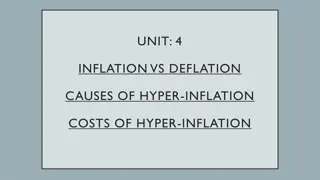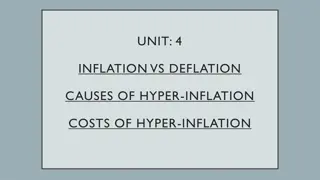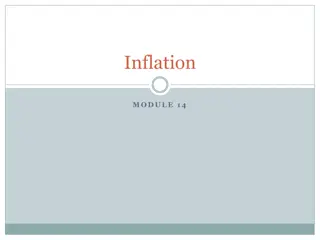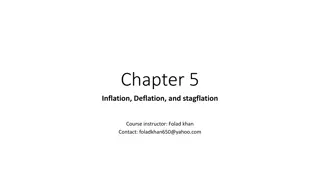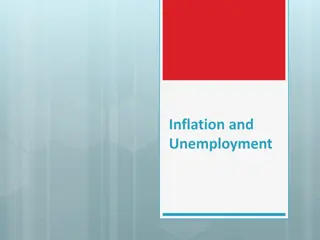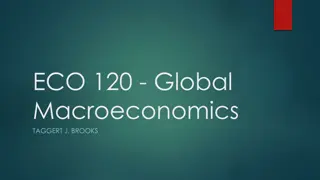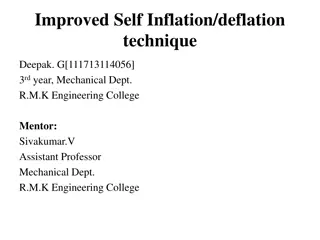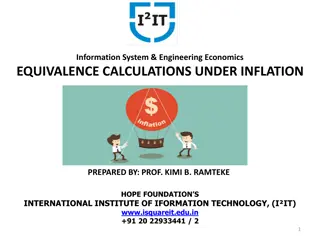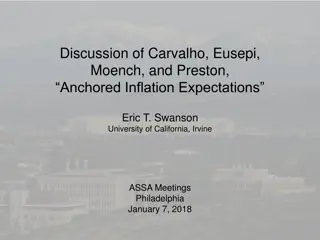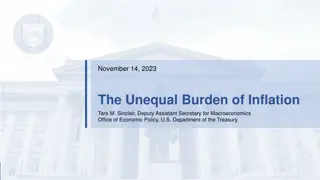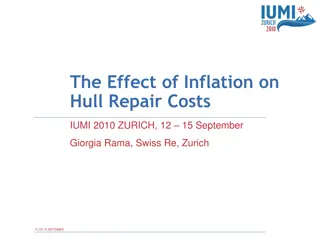Understanding Types and Causes of Inflation
Inflation is a situation where the general price level rises, impacting the value of money. Types include Creeping, Galloping, Hyper, Core, and Food Inflation. Causes stem from both demand and supply sides of an economy, categorized as Demand-pull Inflation. Explore the nuances and impacts of different types of inflation in different economic settings.
Download Presentation

Please find below an Image/Link to download the presentation.
The content on the website is provided AS IS for your information and personal use only. It may not be sold, licensed, or shared on other websites without obtaining consent from the author. Download presentation by click this link. If you encounter any issues during the download, it is possible that the publisher has removed the file from their server.
E N D
Presentation Transcript
Inflation is a situation in which the general price level rises or the value of money falls. Types of Inflation: On the basis of the rate of increase in price level we have three types of inflation, (i) Creeping Inflation: It is also known as mild-inflation. It is not dangerous specially in an economy where national income is also rising. There are some economists who regard a mild increase in the price level as a necessary condition for economic growth.
(ii) Galloping Inflation: If mild inflation is not checked and if it is allowed to go uncontrolled, it may assume the character of the galloping inflation. It may have adverse effect on saving and investment in the economy. (iii) Hyper-Inflation: A final stage of inflation is hyper-inflation. It occurs when the Priceline goes out of control and the monetary authorities find it beyond their resources to impose any checks on it. At this stage, there is no limit to which the price level may rise.
(IV) Core Inflation The core inflation rate measures rising prices in everything except food and energy. That's because gas prices tend to escalate every summer. Families use more gas to go on vacation. Higher gas costs increase the price of food and anything else that has high transportation costs. (v) Food Inflation The condition of an increase in the wholesale price index of a necessary food item relative to the general index or the consumer price index (CPI) is referred to as food inflation. In layman s language, it is basically the rise in the cost of an
essential food item relative to the previous price. Food inflation has two meanings; it means one thing in the developed countries and underdeveloped/developing countries. In the developed countries, the rise in the food prices causes a small inconvenience, something to groan about. While an increase in the food prices in developing countries, the people might not get sufficient amounts to eat and might as well starve for food. Food inflation is quite volatile. The volatility actually depends on agricultural prices as the change in the weather, supply, and demand in the agricultural sector tend to vary. another for the
Causes of Inflation Inflation is a sustained rise in the general price level. Inflation can come from both the demand and the supply-side of an economy The causes of inflation may be grouped under two headings: (1) Demand-pull Inflation: The inflation represents a situation whereby The pressure of aggregate demand for goods and services exceeds the available supply of output. In such situation, the rise in price level is the natural consequence.
Now this excess of aggregate demand over supply may be the result of more than one force at work. As we know, aggregate demand is the sum of consumer s spending on current goods and services and net investment being contemplated by the entrepreneurs.
The X-axis measures the aggregate demand and supply and the Y-axis measures the General price level. The curve AS represents the aggregate supply which rises upward in the beginning but when a full-employment level of aggregate supply OYFis achieved, the supply curve of AS takes a vertical shape. This is because once full employment is achieved, a supply of output cannot be increased. When the aggregate demand curve is AD1the equilibrium is at less the complete employment level in which the price level of OP1is arrived at. If the aggregate demand increases to AD2, the price level will rise to OP2due to excessive demand at price OP1.
The rise in price level has led to an increase in the output supplied from OY1to OP2.If the demand further pushes to AD3,the price level also increases to OP3,under more demand pressure. However, since the aggregate supply curve is still sloping upward, an increase in aggregate demand from AD2to AD3has utilized the increase in output from OY2to OYF. If aggregate demand increases to say AD4,only price level shall rise to OP4, with output remaining constant at YF. OYFis the full employment level/ output and the aggregate supply curve is perfectly inelastic at YF.
The demand-pull inflation is caused by the following in an economy.
Cost-Push Inflation Cost-push inflation is caused by wage increases enforced by unions and profit increases by employers. Cost-push inflation is caused by wage-push and profit-push to prices. The basic cause of cost-push inflation is the rise in money wages more rapidly than the productivity of labour. In advanced countries, trade unions are very powerful. They press employers to grant wage increases considerably in excess of increases in the productivity of labour. Employers, in turn, raise prices of their products. Higher wages enable workers to buy as much as before, in spite of
higher prices. On the other hand, the increase- in prices induces unions to demand still higher wages. In this way, the wage-cost spiral continues, thereby leading to cost-push or wage-push inflation. Again, a few sectors of the economy may be affected by money wage increases and prices of their products may be rising. In many cases, their products are used as inputs for the production of commodities in other sectors. As a result, production costs of other sectors will rise and thereby push up the prices of their products. Thus wage-push inflation in a few sectors of the economy may soon lead to inflationary rise in prices in the entire economy.
Further, an increase in the price of domestically produced or imported raw materials may lead to cost- push inflation. Since raw materials are used as inputs by the manufacturers of finished goods, they enter into the cost of production of the latter. Thus a continuous rise in the prices of raw materials tends to set off a cost- price-wage spiral. Another cause of cost-push inflation is profit-push inflation. Oligopolist and monopolist firms raise the prices of their products to offset the rise in labour and production costs so as to earn higher profits. There being imperfect competition in the case of such firms, they are able to administer prices of their products.
Cost-push inflation is illustrated in Figure (A) and (B). First consider Panel (B) of the figure where the supply curves S0S and S1S are shown as increasing functions of the price level up to full employment level of income YF. Given the demand conditions as represented by the demand curve D, the supply curve S0is shown to shift to S1in response to cost-increasing pressures of oligopolies, unions, etc. as a result of rise in money wages. Consequently, the equilibrium position shifts from E to E1reflecting rise in the price level from P to P1and fall in output, employment and income from YFto Y1level.
Now consider the upper Panel (A) of the figure. As the price level rises, the LM curve shifts to the left to LM1because with the increase in the price level to P1the real value of the money supply falls. Similarly, the IS curve shifts to the left to IS1because with the increase in the price level, the demand for consumer goods falls due to the Pigou effect. Accordingly, the equilibrium position of the economy shifts from E to E1where the interest rate increases from R to R1and the output, employment and income levels fall from the full employment level of YFto Y1.
Effects of Inflation The following are six major effects of inflation. 1. Effects on Distribution of Income and Wealth 2. 2. Effects on Production 3. 3. Effects on Income and Employment 4. 4. Effects on Business and Trade 5. 5. Effects on the Government Finance 6. 6. Effects on Growth.
1. Effects on Distribution of Income and Wealth: The impact of inflation is felt unevenly by the different groups of individuals within the national economy some groups of people gain by making big fortune and some others lose. (a) Creditors and debtors: During inflation creditors lose because they receive in effect less in goods and services than if they had received the repayments during a period of low prices. Debtors, on other hand, as a group gain during inflation, since they repay their debts in currency that has lost its value (i.e., the same currency unit will now buy less goods and services).
(b) Producers and workers: Producers gain because they get higher prices and thus more profits from the sale of their products. As the rise in prices is usually higher than the increase in costs, producers can earn more during inflation. But, workers lose as they find a fall in their real wages as their money wages do not usually rise proportionately with the increase in prices. They, as a class, however, gain because they get more employment during inflation.
(c) Fixed income-earners: Fixed income-earners like the salaried people, rent-earners, landlords, pensioners, etc., suffer greatly because inflation reduces the value of their earnings. (d) Investors: The investors in equity shares gain as they get dividends at higher rates because of larger corporate profits and as they find the value of their shareholdings appreciated. But the bondholders lose as they get a fixed interest the real value of which has already fallen.
(e) Traders, speculators, businesspeople and black- marketers: They gain because they make more profits from the persistent rise in prices. (f) Farmers: Farmers also gain because the rise in the prices of agricultural products is usually higher than the increase in the prices of other goods.
Thus, inflation brings a shift in the pattern of distribution of income and wealth in the country, usually making the rich richer and the poor poorer. Thus during inflation there is more and more inequality in the distribution of income. 2. Effects on Production: The rising prices stimulate the production of all goods both of consumption and of capital goods. As producers get more and more profit, they try to produce more and more by utilising all the available resources at their disposal. But, after the stage of full employment the production cannot increase as all the resources are fully employed. Moreover, the
producers and the farmers would increase their stock in the expectation of a further rise in prices. As a result hoarding and cornering of commodities will increase. But such favourable effects of inflation upon production are not always found. Sometimes, production may come to a standstill position despite rising prices, as was found in recent years in developing countries like India, Thailand and Bangladesh. This situation is described as stagflation. 3. Effects on Income and Employment: Inflation tends to increase the aggregate money income (i.e., national income) of the community as a whole on account of
larger spending and greater production. Similarly, the volume of employment increases under the impact of increased production. But the real income of the people fails to increase proportionately due to a fall in the purchasing power of money. 4. Effects on Business and Trade: The aggregate volume of internal trade tends to increase during inflation due to higher incomes, greater production and larger spending. But the export trade is likely to suffer on account of a rise in the prices of domestic goods. However, the business firms expand their businesses to make larger profits.
During most inflation since costs do not rise as fast as prices profits soar. But wages do not increase proportionate with prices, causing hardships to workers and making more and more inequality. As the old saying goes, during inflation prices move in escalator and wages in stairs. 5. Effects on the Government Finance: During inflation, the government revenue increases as it gets more revenue from income tax, sales tax, excise duties, etc. Similarly, public expenditure increases as the government is required to spend more and more for administrative and
other purposes. But the rising prices reduce the real burden of public debt because a fix sum has to be paid in instalment per period. 6. Effects on Growth: A mild inflation promotes economic growth, but a runaway inflation obstructs economic growth as it raises cost of development projects. Although a mild dose of inflation is inevitable and desirable in a developing economy, a high rate of inflation tends to lower the growth rate by slowing down the rate of capital formation and creating uncertainty.




